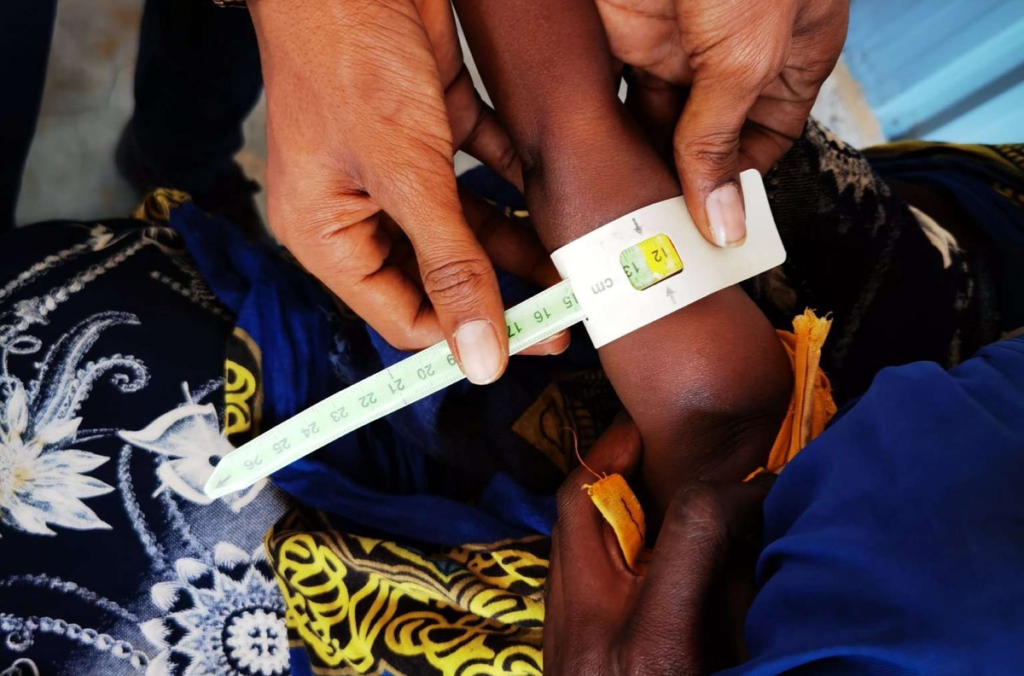Sudan is facing a tragic food insecurity problem as a result of years of drought, high commodity prices, violence, and displacement. With the conflict that has gripped the country since April 2023, the situation has deteriorated, with access to food limited by a lack of cash, escalating food prices, unprecedented mass displacement, difficult access to water, sanitation, and hygiene, and disease outbreaks due to a lack of access to health care. More than 20 million people in Sudan are suffering from severe food insecurity. It is estimated that 4 million women and children are severely malnourished today and that over 100,000 children under the age of five require 24-hour specialized inpatient treatment at stabilization centers for severe acute malnutrition with complications.
In this article, we are going to explore the symptoms, causes, and remedies for malnutrition, and what MOAS is doing to respond to this crisis.
What is malnutrition and what are the symptoms?
Malnutrition is defined, by the World Health Organization (WHO), as deficiencies, excesses or imbalances in a person’s intake of energy and/or nutrients. This means that under the term malnutrition, there are two different conditions: under-nutrition, which includes stunting, wasting, underweight and micro-nutrient deficiencies or insufficiency; and overweight, which includes obesity and diet-related diseases.
Malnutrition affects overall health and quality of life, leaving one at greater risk of contracting diseases or worsening the prognosis of already existing illnesses.
The common signs of malnutrition include:
• Unintentional weight loss: losing 5% to 10% or more of weight over 3 to 6 months;
• A low body weight: People with a body mass index (BMI) under 18.5 are considered at risk of malnutrition;
• a lack of interest in eating and drinking;
• feeling of tiredness
• facility to get ill often and need a long time for recovery;
• feeling weak;
• For children: not growing or putting on weight at the expected rate.
Malnutrition usually manifests itself in substantial weight loss due to the consumption of fat deposits and muscle mass. This results in thinning of the skin, protrusion of bones, pallor and hair loss.
A child suffering from acute malnutrition is extremely undernourished. Acute malnutrition stunts growth, impairs physical and mental development, raises the chance of developing life-threatening infections, causes muscular atrophy to the point of inability to walk, and eventually leads to death. The diagnosis is made by measuring the circumference of the child’s arm using a specific bracelet called the MUAC (Mid Upper Arm Circumference), which determines the child’s nutritional status.
Malnutrition is 100% preventable. The best way to prevent malnutrition is to eat healthy and balanced.
Even if malnutrition is a preventable condition, around 45% of deaths among children under 5 years of age are linked to undernutrition. These mostly occur in low- and middle-income countries. Poverty increases the likelihood of, and the consequences of, malnutrition. Malnutrition also raises healthcare expenses, diminishes productivity, and slows economic growth, thereby perpetuating a cycle of poverty and illness.
Moreover, the consequences of climate change and extreme weather conditions, such a floods and drought, are making food shortages more and more common. Food insecurity is a serious problem in low- and middle-income countries, whose populations are facing various difficulties in accessing enough safe and nutritious food for the normal growth and development of children.
Different types of malnutrition
FAO carried out research on food insecurity, measuring the indicators of moderate and severe food insecurity in a population.
People with moderate food insecurity have reduced the quality and/or quantity of their meals and are unsure of their capacity to receive food owing to a lack of money or other resources. Moderate food insecurity can increase the risk of some types of malnutrition, such as stunting in children, micro-nutrient deficiencies, or adult obesity.
People suffering from severe food insecurity have run out of food and, in extreme cases, have gone days without eating. The “hungry” are a subset of this population.
How is MOAS responding?
Since 2019, MOAS has been working in Yemen and Somalia together with our partners to provide therapeutic food to combat malnutrition in children.
This year MOAS decided to expand its mission against malnutrition in Sudan, starting the humanitarian aid project #MOASforSudan. Our mission consists of the shipping of therapeutic and supplementary (RUS/FT) food to be distributed among the vulnerable population in Sudan, in order to contribute to the fight against malnutrition, especially among children.
What is RUS/TF?
The acronym RUSF means Ready to Use Supplementary food used to treat Severe Acute Malnutrition (SAM, while RUTF stands for Ready to Use Therapeutic Food used to treat Moderate Acute Malnutrition (MAM). Both are ready-to-use food, which means that they do not require cooking, mixing, or dilution with water or other liquids, and they are both based on lipid paste. The primary objective of this food is to recover and gain weight in malnourished children between 6 and 59 months of age.
Here is the description of the different types of RUSF and RUTF which are being shipped in Sudan:
• Plumpy’doz: It provides calories, protein, and essential nutrients for children with diets that are not meeting their nutritional needs. LNS-MQ is commonly part of blanket feeding supplementation programs that target children based on age and demographic and is frequently used in emergency situations.
• Plumpy’Sup: is commonly part of targeted feeding supplementation programs and is frequently used in emergency situations. It is not meant to replace a child’s diet, but to supplement it with necessary micro- and macro-nutrients for recovery.
• Plumpy Nut: is a formulation based on F-100 milk powder and complies with the World Health Organization’s definition of RUTF. It is primarily distributed through Community-based Management of Acute Malnutrition (CMAM) programs throughout the world—where home-based feeding with RUTF is prescribed by a medical professional working within the local health system.
With your donation, you can contribute to the distribution of supplementary and therapeutic food which will save many lives in Sudan. With as little as a 15 USD donation, you can feed a malnourished child for one month.
Make a difference, give what you can now
https://www.moas.eu/donate-moas-sudan/


